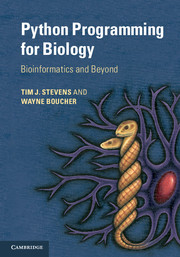Book contents
- Frontmatter
- Contents
- Preface
- Acknowledgements
- 1 Prologue
- 2 A beginners’ guide
- 3 Python basics
- 4 Program control and logic
- 5 Functions
- 6 Files
- 7 Object orientation
- 8 Object data modelling
- 9 Mathematics
- 10 Coding tips
- 11 Biological sequences
- 12 Pairwise sequence alignments
- 13 Multiple-sequence alignments
- 14 Sequence variation and evolution
- 15 Macromolecular structures
- 16 Array data
- 17 High-throughput sequence analyses
- 18 Images
- 19 Signal processing
- 20 Databases
- 21 Probability
- 22 Statistics
- 23 Clustering and discrimination
- 24 Machine learning
- 25 Hard problems
- 26 Graphical interfaces
- 27 Improving speed
- Appendices
- Glossary
- Index
- Plate section
- References
19 - Signal processing
Published online by Cambridge University Press: 05 February 2015
- Frontmatter
- Contents
- Preface
- Acknowledgements
- 1 Prologue
- 2 A beginners’ guide
- 3 Python basics
- 4 Program control and logic
- 5 Functions
- 6 Files
- 7 Object orientation
- 8 Object data modelling
- 9 Mathematics
- 10 Coding tips
- 11 Biological sequences
- 12 Pairwise sequence alignments
- 13 Multiple-sequence alignments
- 14 Sequence variation and evolution
- 15 Macromolecular structures
- 16 Array data
- 17 High-throughput sequence analyses
- 18 Images
- 19 Signal processing
- 20 Databases
- 21 Probability
- 22 Statistics
- 23 Clustering and discrimination
- 24 Machine learning
- 25 Hard problems
- 26 Graphical interfaces
- 27 Improving speed
- Appendices
- Glossary
- Index
- Plate section
- References
Summary
Signals
In science many different kinds of experiment involve the recording of signals: series of measurements that represent the variation in some kind of underlying physical property. The signal can then be interpreted, based on some theoretical model of the experiment. Commonly the recorded signal is one that varies over time, such as sound or radio waves, but it could also represent a variation in space, or indeed along any other kind of axis. In general a signal is represented by values that are directly recorded by instruments at specific, usually regular, intervals; although in some situations derived data, like a DNA sequence, can also be thought of in terms of signals.
If a signal varies in a regular manner, i.e. oscillates, then it is often the frequencies that occur within the signal that are of interest, rather than the original signal itself. This is because the underlying frequencies are generally characteristic of what made the signal. To take a toy example, if we have a peal of bells, where each bell has a different tone, we can record the variation of the overall sound signal over time. Then, by looking at the component frequencies we can discern the tones of the individual bells that made the sound. As we will illustrate, it is possible to convert the time signal into a spectrum of its component frequencies using what is known as a Fourier transform.
- Type
- Chapter
- Information
- Python Programming for BiologyBioinformatics and Beyond, pp. 382 - 400Publisher: Cambridge University PressPrint publication year: 2015



